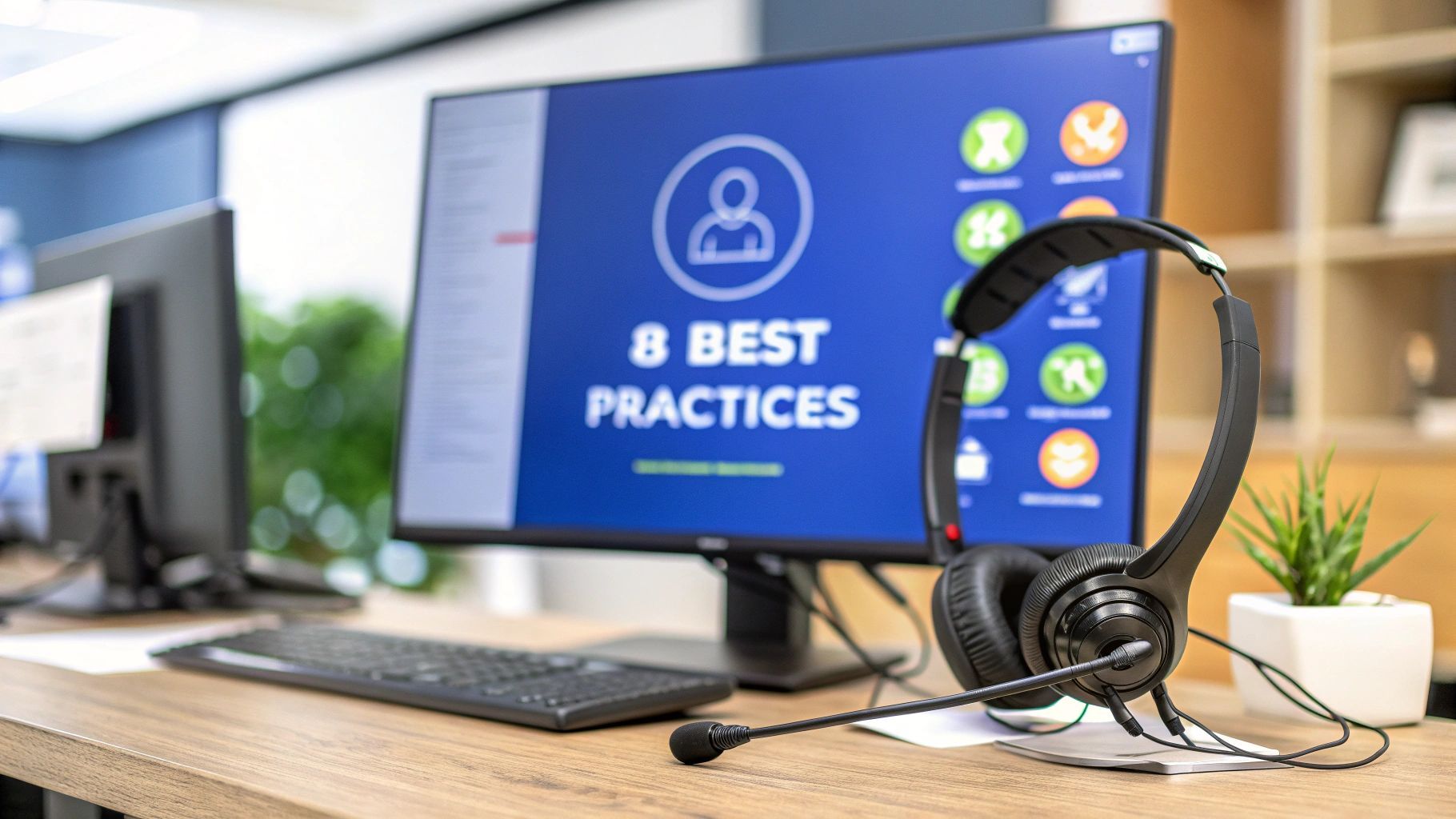
8 Call Center Training Best Practices for 2025
Discuss with AI
Get instant insights and ask questions about this topic with AI assistants.
💡 Pro tip: All options include context about this blog post. Feel free to modify the prompt to ask more specific questions!
In today's competitive e-commerce and D2C landscape, exceptional customer support is no longer a luxury; it's a core driver of retention and growth. Yet, many support teams are held back by outdated training models that fail to prepare agents for the complexity and speed of modern customer interactions. The result is often high agent turnover, inconsistent service quality, and declining Customer Satisfaction (CSAT) scores. To build a truly high-performing team, you need a training program that is as dynamic and intelligent as the customers you serve.
This guide moves beyond generic advice to deliver a curated roundup of the most effective call center training best practices for today's demanding environment. We will explore eight actionable strategies, from creating a comprehensive, tech-driven onboarding program to implementing continuous, performance-based coaching. You will learn how to leverage AI-powered simulations, foster essential soft skills, and build a culture of constant improvement. Each practice is designed to be implemented directly, helping you boost agent efficiency, reduce onboarding time, and transform your support center into a powerful engine for customer loyalty. Forget the old playbook; it's time to supercharge your support team with strategies that deliver measurable results.
The foundation of a high-performing call center is an immersive and structured onboarding program. This isn't just a two-day crash course; it's a multi-week, deep-dive curriculum that systematically prepares new agents for the complexities of their role. A truly effective program goes beyond basic scripts and system navigation, instilling a deep understanding of company culture, product intricacies, and the core philosophies behind exceptional customer service.

This method ensures agents are not just competent but confident before their first live interaction. By investing heavily upfront, you reduce early-stage attrition, minimize initial errors, and build a consistent customer experience from day one. Companies like Zappos, famous for its four-week paid training, prove that dedicating time to cultural and procedural immersion creates agents who are true brand ambassadors. This approach is one of the most vital call center training best practices for long-term success.
- Structure with Progressive Complexity: Start with fundamentals like company values and basic system logins. Gradually introduce more complex scenarios, product details, and de-escalation techniques each week.
- Integrate Hands-On Practice: Agents should spend significant time in a sandboxed or training version of your CRM and phone systems. This builds muscle memory without the risk of impacting real customers.
- Schedule Shadowing and Reverse Shadowing: Have new hires listen in on top-performing agents. Follow this with reverse shadowing, where a seasoned agent listens to the new hire's practice calls and provides immediate, constructive feedback.
- Implement Checkpoint Assessments: Use short quizzes, practical tests, and role-playing scenarios at the end of each module to ensure comprehension before moving on. Automating parts of this process can significantly improve efficiency; discover more about customer onboarding automation on spurnow.com.
Beyond theoretical knowledge, agents must develop practical, in-the-moment skills. Role-playing and simulation training provide a controlled, risk-free environment for agents to apply what they've learned, building confidence and honing their conversational abilities. This interactive method involves acting out realistic customer scenarios, from simple inquiries to high-stress complaint calls, allowing trainees to practice empathy, problem-solving, and de-escalation in real-time.

This hands-on approach transforms abstract training concepts into tangible skills. By simulating the pressures of a live call, agents can make mistakes, receive immediate feedback, and refine their approach without impacting customer satisfaction. Hospitality leaders like Ritz-Carlton and Disney have long used simulation to instill their legendary service standards, proving that practiced responses lead to superior customer interactions. This makes interactive simulation a cornerstone of effective call center training best practices.
- Use Real Scenarios: Pull scripts and situations directly from your call recordings. Use a mix of common, everyday calls and the more complex, emotionally charged interactions to prepare agents for a full spectrum of possibilities.
- Rotate Roles and Responsibilities: Have trainees switch between playing the agent, the customer, and an observer. This provides a 360-degree perspective on the interaction, building empathy for the customer's position and sharpening critical feedback skills.
- Record and Review Sessions: Video record role-playing exercises. Watching playback allows agents to see their own body language and hear their tone, providing powerful, objective insights for improvement. The debriefing session is as important as the simulation itself.
- Incorporate Both Routine and Challenging Scenarios: Ensure training covers both the high-frequency, low-difficulty calls and the low-frequency, high-stakes situations. This prepares agents to handle everything from a simple password reset to a major service outage complaint with equal proficiency.
Initial onboarding is crucial, but the best call centers treat agent education as an ongoing journey, not a one-time event. A culture of continuous learning and development ensures that agents' skills evolve alongside customer expectations, new technologies, and product updates. This approach moves beyond sporadic training sessions to an integrated system of regular skill refreshers, career pathing, and knowledge enhancement.

This commitment to growth keeps your team sharp, agile, and engaged, directly impacting long-term retention and performance. When agents see a future and a path for advancement, their motivation and loyalty increase. Companies like Amazon invest heavily in programs like Career Choice for their customer service employees, recognizing that supporting personal and professional growth creates a more skilled and dedicated workforce. This makes ongoing education one of the most impactful call center training best practices you can adopt.
- Utilize Bite-Sized Learning Modules: Deliver training in short, digestible formats like micro-videos, quick-read articles, or interactive quizzes. This "just-in-time" learning allows agents to absorb new information without being pulled from their duties for long periods.
- Create Individual Development Plans (IDPs): Work with each agent to map out their career goals. An IDP should outline specific skills to develop, training to complete, and milestones to achieve, making their growth path clear and measurable.
- Tie Learning to Performance and Incentives: Connect the completion of training modules or the acquisition of new skills to performance metrics, bonuses, or promotional opportunities. This creates a clear and tangible benefit for engaging in continuous education.
- Offer Diverse Learning Formats: Cater to different learning styles by providing a mix of resources. Offer workshops for collaborative learners, self-paced online courses for independent agents, and expert-led webinars for deep dives into specific topics.
Gone are the days of static PowerPoint presentations and dense training manuals. Modern call centers are leveraging a suite of powerful technologies to create dynamic, engaging, and highly effective learning environments. Technology-enhanced training integrates tools like AI-powered coaching platforms, virtual reality (VR) simulations, and gamified learning modules to accelerate skill acquisition and improve knowledge retention in ways traditional methods cannot.

This approach transforms training from a passive experience into an active, immersive one. By providing agents with realistic, risk-free environments to practice complex interactions, you build their confidence and competence simultaneously. For example, Walmart uses VR to train associates for challenging customer service scenarios, while AT&T employs AI-driven platforms to deliver personalized learning paths for its technical support staff. Implementing this strategy is one of the most impactful call center training best practices for a modern, tech-savvy workforce.
- Integrate Gamification Elements: Incorporate points, badges, and leaderboards into your Learning Management System (LMS) to foster friendly competition and make learning feel more like a game than a chore. Starbucks' gamified app for barista training is a prime example of this in action.
- Utilize AI-Powered Coaching and Simulations: Deploy AI tools that can simulate customer conversations, analyze agent responses for tone and empathy, and provide instant, objective feedback. This allows for scalable, consistent coaching without constant human supervision.
- Leverage Virtual Reality for De-escalation: For handling highly emotional or complex customer issues, use VR simulations. This technology can safely immerse agents in stressful situations, helping them practice and master de-escalation techniques in a controlled setting.
- Ensure Mobile-First Accessibility: Choose training platforms that are fully mobile-compatible. This allows agents to access micro-learning modules, quizzes, and refreshers on-the-go, accommodating flexible schedules and promoting continuous learning.
Technical proficiency and product knowledge are only half the equation in a successful customer interaction. The other half relies on an agent's soft skills: their ability to connect, empathize, and communicate with a human touch. Focused soft skills development transforms agents from mere problem-solvers into genuine relationship-builders who can de-escalate tense situations and foster customer loyalty. This training is a cornerstone of modern call center training best practices.
This approach ensures customers feel heard and valued, not just processed. Investing in skills like active listening, empathy, and emotional intelligence directly impacts key metrics like Customer Satisfaction (CSAT) and Net Promoter Score (NPS). Companies like Nordstrom and Virgin Atlantic build their legendary service reputations on agents trained to prioritize the customer's emotional experience, proving that how you say something is often more important than what you say.
- Incorporate Real Customer Feedback: Use anonymized call recordings and customer survey comments to build training modules. When agents hear firsthand how a lack of empathy impacts a customer, the importance of soft skills becomes tangible.
- Practice Active Listening with Call Reviews: Dedicate coaching sessions to reviewing recorded calls, but focus specifically on listening skills. Pause the call and ask the agent what the customer's unspoken need was or to identify the emotional cues they might have missed.
- Introduce Stress Management Techniques: Equip agents with tools to manage their own emotional state during difficult calls. This can include simple mindfulness exercises, breathing techniques, or strategies for taking a mental reset between interactions to prevent burnout.
- Utilize Role-Playing for Difficult Conversations: Create realistic scenarios that challenge agents to use empathy and de-escalation skills. Provide immediate feedback from peers and trainers in a safe, controlled environment. To dive deeper, explore these essential customer service skills training techniques on spurnow.com.
Beyond formal classroom training, a structured mentorship or buddy system provides the essential human element that accelerates agent development. This practice pairs new hires with seasoned, high-performing agents who act as a guide, confidant, and real-time resource. This relationship bridges the gap between theoretical knowledge gained during onboarding and the practical, nuanced realities of live customer interactions, making it one of the most effective call center training best practices.
This system creates a safe space for new agents to ask questions they might be hesitant to bring up in a group setting. It humanizes the learning process and fosters a sense of belonging and support, which is critical for reducing early turnover. Companies like General Electric and Ernst & Young have long championed these programs, understanding that direct guidance from a trusted peer is invaluable for navigating both procedural and cultural challenges. The buddy system transforms a daunting first few months into a supported, collaborative journey.
- Select Mentors Carefully: Choose mentors based not only on their performance metrics but also on their patience, communication skills, and genuine desire to teach. A top performer isn't always a great teacher, so look for a combination of skill and disposition.
- Provide Mentor Training: Equip your chosen mentors with basic coaching and feedback techniques. Train them on how to provide constructive, encouraging advice and how to handle common new hire anxieties.
- Establish Clear Goals and Expectations: Define the purpose of the relationship. Outline specific goals for the first 30, 60, and 90 days, including areas like system navigation mastery, call handling time reduction, and first-call resolution improvement.
- Facilitate Regular Check-ins: Structure the program with scheduled check-ins, but also encourage informal interactions. Regular, brief meetings ensure the relationship stays on track and provides a consistent forum for addressing challenges as they arise.
- Recognize and Reward Mentors: Acknowledge the extra effort mentors put in. This can be through bonuses, public recognition, or considering mentorship participation as a key factor in career advancement opportunities.
Moving beyond a one-size-fits-all approach, performance-based training utilizes real data to deliver targeted and highly effective coaching. This methodology shifts training from a generic, scheduled event to a continuous, data-driven process. It leverages quality assurance metrics, call monitoring insights, and individual performance analytics to pinpoint specific skill gaps and behavioral patterns that need improvement.
This practice ensures that coaching time is spent exactly where it's needed most, making it incredibly efficient and impactful. Instead of reteaching an entire module on empathy, a manager can use call recordings to show an agent specific moments where their tone could have been softer or their phrasing more understanding. Companies like Chase Bank and Verizon have championed this data-driven development, creating feedback loops that directly link performance metrics to personalized coaching interventions, which is a cornerstone of modern call center training best practices.
- Balance Quantitative and Qualitative Feedback: Don't just focus on metrics like Average Handle Time (AHT). Pair quantitative data with qualitative insights from call reviews to provide a complete picture of an agent's performance.
- Focus on Improvement, Not Punishment: Frame coaching sessions around growth and development. The goal is to build skills and confidence, not to penalize agents for mistakes. Use a collaborative tone to foster trust and openness.
- Provide Specific, Actionable Coaching Points: Vague feedback like "be more empathetic" is unhelpful. Instead, say, "In that last call, when the customer expressed frustration, a good next step would have been to use an acknowledging phrase like, 'I can certainly understand why that would be upsetting.'"
- Conduct Regular Calibration Sessions: Ensure all team leads and QA specialists are evaluating calls using the same standards. This consistency is crucial for fair and effective coaching across the entire team. To build a robust framework, it's essential to understand the principles of customer service quality assurance at spurnow.com.
A static, single-skilled agent pool is a liability in a dynamic business environment. Cross-training and skill diversification transform your team into a versatile, resilient force capable of adapting to fluctuating call volumes, new product launches, or shifts between service channels. This practice involves training agents on multiple product lines, service tiers, or communication platforms, such as moving from phone support to live chat or social media.
This strategic approach breaks down knowledge silos and creates a more agile workforce. When one queue is overwhelmed, cross-trained agents can be redeployed to balance the load, dramatically reducing customer wait times and preventing agent burnout. Companies like Amazon excel at this, training their customer service associates to handle a wide array of inquiries, from retail returns to AWS technical support, ensuring seamless support across their vast ecosystem. This flexibility is a cornerstone of modern call center training best practices.
- Start with Adjacencies: Begin by training agents on products or services closely related to their primary area of expertise. For example, an agent specializing in one software module can be trained on a complementary module, making the learning curve less steep.
- Create Tiered Certification Programs: Develop a formal system to track and recognize new skills. Offer "Level 1" certification in a new area, followed by "Level 2" for advanced proficiency. This gamifies the learning process and provides clear milestones.
- Incentivize Skill Acquisition: Tie cross-training directly to career advancement and compensation. Offer a small pay increase, a one-time bonus, or eligibility for promotion upon successful completion of a new skill certification.
- Maintain a Balance of Specialization and Breadth: While versatility is the goal, ensure agents remain deep experts in at least one core area. The aim is to create "T-shaped" professionals who have a primary specialty (the vertical bar of the T) and broad knowledge in other areas (the horizontal bar).
Training Method Implementation Complexity 🔄 Resource Requirements 💡 Expected Outcomes 📊 Ideal Use Cases 💡 Key Advantages ⭐ Comprehensive Onboarding Program High 🔄🔄🔄 Dedicated trainers, time intensive Confident agents, consistent service quality New hires needing full foundational training Reduces turnover, improves resolution rates Role-Playing and Simulation Training Medium 🔄🔄 Skilled facilitators, setup time Improved communication, problem-solving Skill practice in controlled environment Safe mistakes, prepares for difficult calls Continuous Learning and Development Medium to High 🔄🔄🔄 Ongoing investment, LMS systems Up-to-date skills, employee retention Long-term skill maintenance and growth Adapts to changes, supports career growth Technology-Enhanced Training High 🔄🔄🔄 Technology infrastructure, support Engaging, scalable, consistent training Digital-native workforce, large scale Self-paced learning, detailed analytics Soft Skills Development Medium 🔄🔄 Experienced trainers, time Improved customer satisfaction, reduced conflict Enhancing interpersonal skills Builds empathy, stronger relationships Mentorship and Buddy Systems Medium 🔄🔄 Quality mentors, structured program Faster learning, emotional support New hire integration and retention Preserves knowledge, develops leaders Performance-Based Training and Coaching Medium to High 🔄🔄🔄 Monitoring tools, management time Targeted improvements, data-driven results Addressing specific performance gaps Objective feedback, links to business outcomes Cross-Training and Skill Diversification High 🔄🔄🔄 Extensive training resources Flexible workforce, career advancement Multi-product/service environments Operational flexibility, improved engagement
We've explored a comprehensive roadmap of call center training best practices, moving from foundational onboarding and essential soft skills development to advanced strategies like AI-driven simulations and performance-based coaching. The journey to building a world-class support team is not a single event but a continuous cycle of learning, application, and refinement.
The core takeaway is that a truly effective training program is a dynamic ecosystem, not a static manual. It blends the human touch of mentorship with the analytical power of technology. It empowers agents by diversifying their skills through cross-training and reinforces excellence with ongoing, personalized feedback. Adopting these methods transforms training from a simple necessity into a strategic driver for growth.
The ultimate goal of implementing these call center training best practices is to create a tangible, positive impact on your business. When agents are confident, skilled, and motivated, the benefits ripple outward:
- Improved Customer Satisfaction (CSAT): Well-trained agents resolve issues faster and with greater empathy, leading to happier customers who feel heard and valued.
- Increased Agent Retention: Investing in agent growth and development fosters loyalty and reduces costly turnover. A supportive, learning-focused environment is a powerful retention tool.
- Enhanced Operational Efficiency: From AI-powered tools that streamline onboarding to cross-trained agents who can handle diverse query types, your entire operation becomes more agile and resilient.
Embarking on this transformation doesn't require a complete overhaul overnight. The key is to take deliberate, measurable steps. Start by identifying the most significant pain point in your current training process.
Is your onboarding too slow? Focus on integrating technology-enhanced learning modules and a structured buddy system. Are your agents struggling with complex, emotional calls? Prioritize role-playing simulations and soft skills workshops. By selecting one or two key practices to implement first, you can demonstrate value, gather feedback, and build momentum for broader changes.
The path from adequate to exceptional customer service is paved with intentional, strategic investment in your people. By embracing these modern call center training best practices, you are not just teaching agents how to handle calls; you are building a team of expert problem-solvers who serve as the true voice of your brand. This investment is the most critical one you can make for your customer experience and your company's long-term success.
Ready to elevate your support team by automating repetitive questions and freeing up your agents for the conversations that matter most? Discover how Spur uses AI to handle common inquiries, allowing your highly-trained team to apply their skills to complex customer needs. Visit Spur to see how you can transform your customer support today.
